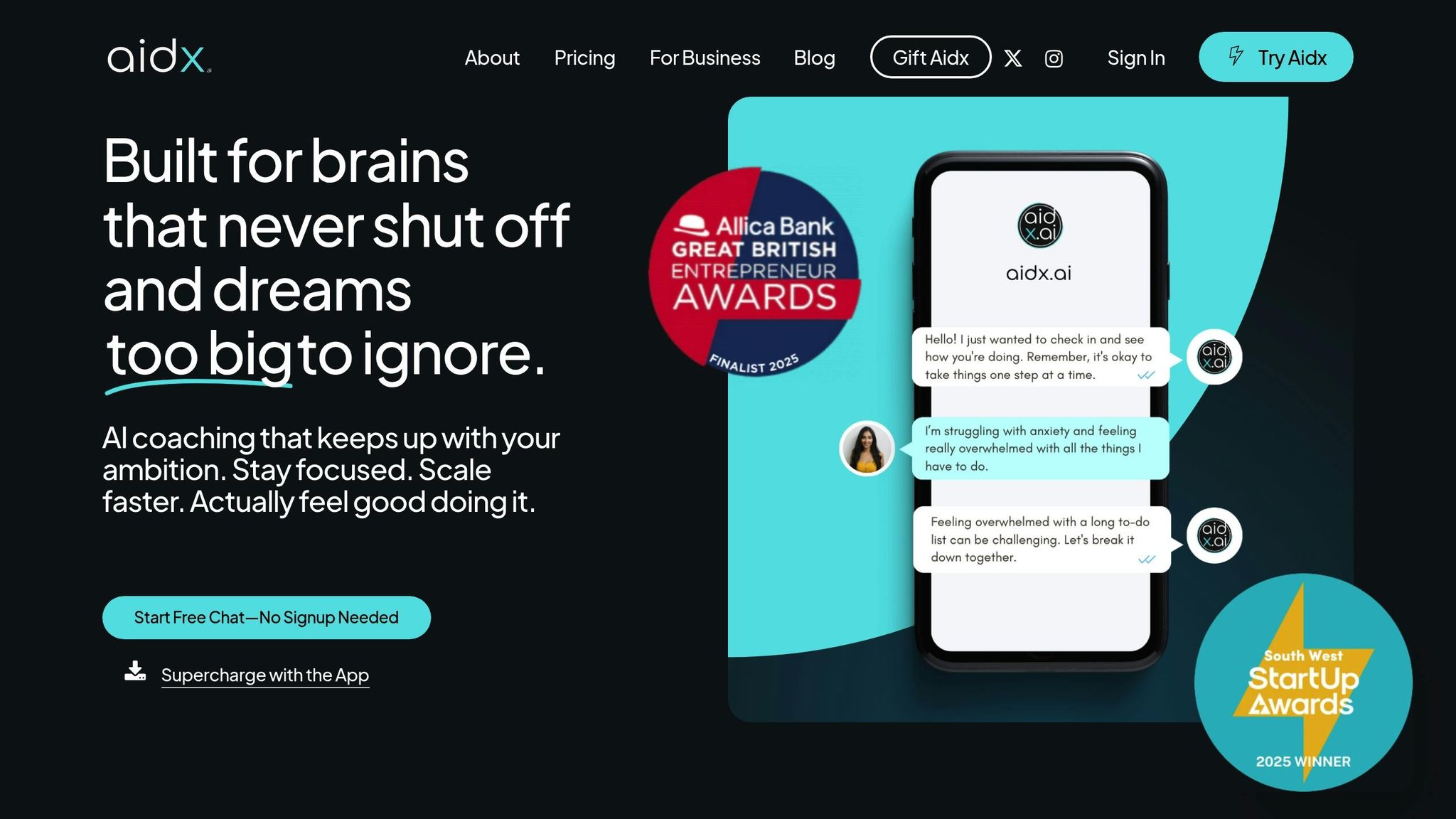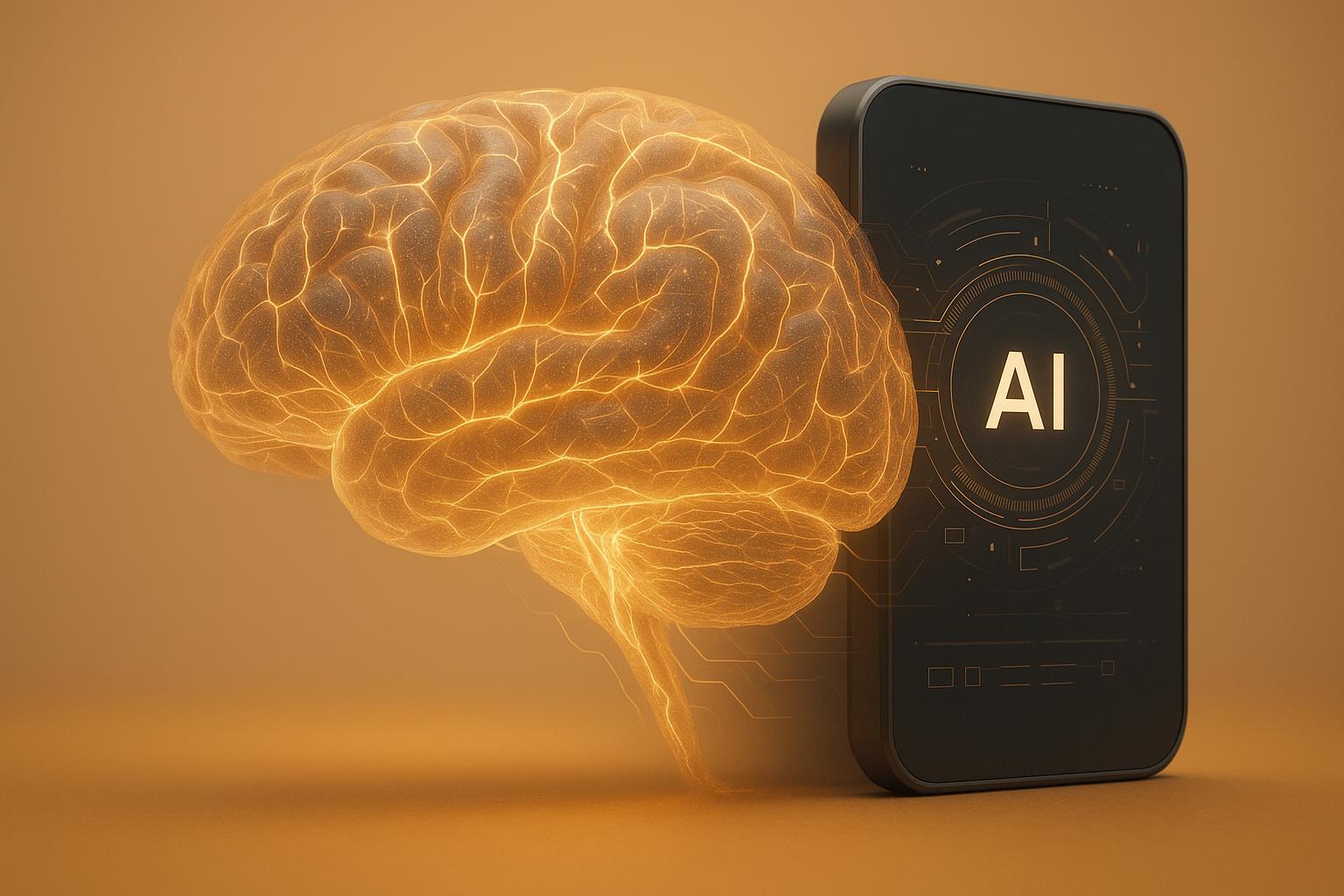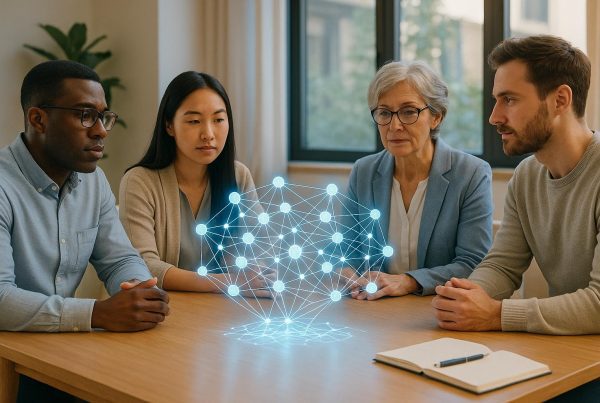AI is reshaping how we learn by mimicking the brain’s natural ability to rewire itself, known as neuroplasticity. This process, where the brain forms and reorganizes neural connections, is the foundation of learning and skill acquisition. AI systems, inspired by these mechanisms, are creating personalized, dynamic learning experiences that adjust to each individual’s progress.
Key takeaways:
- Neuroplasticity allows the brain to strengthen or create new neural connections through experiences, learning, and recovery.
- AI tools replicate this process using neural networks that adapt to new data, improving learning efficiency.
- Applications include adaptive learning platforms, virtual reality (VR) for hands-on training, and tools like Aidx.ai, which focuses on personal growth and emotional intelligence.
While these technologies offer exciting opportunities in education, training, and rehabilitation, ethical considerations like data privacy and transparency are crucial. Combining AI’s capabilities with human oversight ensures these tools remain effective and responsible.
How to Improve at Learning Using Neuroscience & AI | Dr. Terry Sejnowski
Understanding Neuroplasticity: The Brain’s Ability to Change
The human brain is an intricate marvel, housing approximately 100 billion neurons and an estimated 150 trillion synapses [1]. What sets it apart is its ability to adapt and reconfigure itself – a phenomenon known as neuroplasticity. This process enables the brain to reorganize and reshape its neural connections in response to experiences and external stimuli [6]. This adaptability forms the foundation for learning, memory, and even recovery from injury. Below, we’ll explore the science behind neuroplasticity and the factors that influence its remarkable capabilities.
The Science Behind Neuroplasticity
Neuroplasticity relies on several key mechanisms that allow the brain to learn, adapt, and evolve. These processes are the building blocks of how we acquire skills, form memories, and even recover from setbacks.
- Synaptic Plasticity: This involves strengthening or weakening synaptic connections through processes called long-term potentiation (LTP) and long-term depression (LTD). Frequently used connections grow stronger, while inactive ones fade [5].
- Structural Plasticity: The brain physically changes its structure, forming new synapses (synaptogenesis), expanding dendritic branches, and pruning inefficient connections. This reshaping refines neural pathways and optimizes brain function.
- Neurogenesis: New neurons are generated, primarily in the hippocampus, a region critical for memory and learning. Remarkably, around 700 new neurons are added daily to each hippocampus [1], boosting cognitive flexibility and adaptability.
- Functional Reorganization: When needed, the brain can reassign tasks to different regions. This ability to "reroute" functions allows the brain to compensate for damage by engaging underutilized areas, ensuring continued cognitive performance.
Here’s a quick breakdown of these mechanisms and how they contribute to learning and adaptation:
| Mechanism | Description | How It Enables Learning and Adaptation |
|---|---|---|
| Synaptic Plasticity | Adjusts connection strength via LTP and LTD | Reinforces active connections while reducing unused ones |
| Structural Plasticity | Physical changes in neural architecture | Builds new pathways and eliminates inefficient connections |
| Neurogenesis | Creation of new neurons, mainly in the hippocampus | Enhances memory, learning, and cognitive flexibility |
| Functional Reorganization | Reassigns tasks to alternate brain regions | Compensates for damage by utilizing alternative neural pathways |
The brain’s capacity for change is a lifelong process, though it evolves with age. For instance, at birth, neurons in the cerebral cortex have about 2,500 synapses each [3]. By age three, this number skyrockets to 15,000 synapses per neuron [3]. However, as we mature, synaptic pruning trims away unused connections, leaving adults with roughly half as many synapses as in early childhood [7]. This pruning ensures that the brain’s resources are directed toward maintaining and strengthening essential connections.
Key Factors That Influence Neuroplasticity
While the brain’s mechanisms drive its adaptability, several external factors play a critical role in shaping how effectively neuroplasticity occurs:
- Age: The brain is most malleable during early childhood, a period of heightened plasticity when it’s exceptionally receptive to new experiences. While plasticity decreases with age, the adult brain remains capable of change, although it often requires more effort and repetition.
- Environment and Physical Activity: Enriched environments and regular exercise stimulate neuroplasticity. Activities that boost brain-derived neurotrophic factor (BDNF) – a protein essential for neuron growth – can enhance adaptability. Despite making up only about 2% of body weight, the brain consumes roughly 20% of the body’s energy [9].
- Sleep Quality: Sleep is crucial for memory consolidation and dendritic growth. Poor sleep has been linked to a higher risk of cognitive decline, including Alzheimer’s disease [8].
- Stress Management: Chronic stress disrupts neural growth and connectivity by interfering with the production of growth factors. On the flip side, mindfulness and other relaxation techniques can counteract these effects, promoting neural health [2][3].
- Mental Stimulation: Engaging in challenging activities – like learning a new language, solving puzzles, or exploring creative hobbies – encourages neuroplastic changes and keeps the brain sharp throughout life.
Understanding these principles not only sheds light on how our brains adapt but also inspires the development of AI systems that mimic these natural processes. By aligning with the brain’s methods of learning and change, such tools can create more personalized and effective ways to build skills and retain knowledge.
How AI Copies and Improves Neuroplasticity
Artificial intelligence has drawn inspiration from the brain’s remarkable ability to rewire itself, known as neuroplasticity. By mimicking this process, AI systems have learned to adapt, evolve, and refine their performance over time. This brain-inspired approach has led to technologies that emulate human learning patterns while improving them in ways that could transform how we develop skills.
Modern AI systems operate on principles similar to how the brain strengthens useful connections, eliminates inefficient ones, and adjusts to new information. This shift allows AI to move away from rigid, pre-programmed responses toward a more flexible, adaptive learning style. As a result, these systems are becoming dynamic learners capable of evolving far beyond their initial programming.
AI Neural Networks and Learning Algorithms
Artificial Neural Networks (ANNs) are a prime example of how AI applies neuroplasticity concepts. Designed to mirror the brain’s structure and function, these algorithms process information, identify patterns, and learn from experiences in ways that resemble human cognition [10]. ANNs consist of interconnected nodes that transmit and process information, adjusting their connection weights in a manner akin to how the brain’s synapses adapt.
When an AI system encounters new data, it undergoes a structured process: input processing, forward propagation, error calculation, backpropagation, and iterative refinement. Gradient descent algorithms guide this process, helping optimize the system’s internal connections [10].
While both AI neural networks and the human brain rely on iterative learning and optimization, there are key differences. The human brain is vastly more intricate, containing over 100 trillion synapses [4], compared to the millions of parameters in most AI systems [10]. The brain is dynamic, with interconnected feedback loops, while ANNs typically have fixed layers and unidirectional pathways [10]. Another notable distinction is that humans can learn from just a few examples – referred to as "one-shot learning" – whereas ANNs often require extensive datasets with thousands or millions of labeled examples [10].
| Aspect | Human Brain | AI Neural Networks |
|---|---|---|
| Learning Speed | Can learn from single examples | Requires thousands of training examples |
| Knowledge Retention | Maintains existing knowledge while learning new information | Often experiences catastrophic forgetting |
| Complexity | Over 100 trillion synapses | Millions of parameters |
| Architecture | Dynamic with bidirectional feedback | Typically fixed layers, unidirectional |
| Generalization | Excels at abstract concepts | Limited generalization capabilities |
These neural network principles form the backbone of AI systems that are reshaping personalized learning and skill development.
AI’s Role in Personalized Skill Development
By leveraging the adaptive qualities of neural networks, AI systems can restructure themselves dynamically. They adjust their internal configurations as they process new data, eliminating the need for complete retraining cycles [11]. This flexibility allows AI to modify pathways in real time, improving its responsiveness and efficiency [11].
The impact on skill development is already evident. The personalized learning market, valued at $1.8 billion in 2023, is expected to grow to $19.86 billion by 2030 [13], driven by AI’s ability to tailor learning experiences to individual needs. AI-powered learning systems adapt to a learner’s pace, knowledge level, and style, ensuring lessons remain relevant and effective [12].
For instance, an AI-based tutoring system significantly boosted test scores for struggling math students. Those in the lowest pretest quartile improved their scores by an average of 8.2 points, compared to 3.5 points in a control group – an improvement of over 130% [12]. Similarly, an AI model that generated personalized feedback led to a 45% increase in student learning gains [12].
These systems analyze learner behavior, preferences, and progress to deliver customized content and support, creating more engaging and effective educational experiences [12]. By responding to real-time feedback from both students and teachers, AI enhances learning efficiency and makes education more accessible to diverse populations [12].
Experts compare this shift to the groundbreaking transition from hand-coded software to machine learning [11]. As AI continues to evolve, it holds the potential to reshape personalized skill development, tailoring education to each individual’s unique journey. Exploring the shared principles and boundaries of neural and artificial plasticity could lead to further advancements in both AI design and neuroscience, sparking new opportunities for groundbreaking research.
sbb-itb-d5e73b4
AI Tools Using Neuroplasticity for Skill Development
AI-powered tools are tapping into neuroplasticity – the brain’s ability to rewire itself – to help people develop new skills and sharpen their cognitive abilities. These tools range from adaptive learning platforms that adjust to individual needs to immersive technologies that completely reshape how we learn.
Adaptive Learning Platforms
Adaptive learning platforms are changing the way education works by using neuroplasticity as their foundation. These AI-driven systems adjust content, pacing, and teaching methods in real time, making learning more effective. It’s no wonder nearly half of educators now use AI tools in their classrooms [14]. These platforms strengthen neural connections through repetition while trimming away less useful ones through targeted practice.
What makes these systems so effective is their ability to process massive amounts of data quickly and accurately [16]. For instance, if a student struggles with a concept, the platform can analyze the issue and adapt its teaching style. It might switch from visual aids to auditory explanations or break down a challenging topic into smaller, more digestible steps. These programs can even tweak the difficulty of exercises on the fly, ensuring the learner stays in the sweet spot for growth [16].
But adaptive learning is just the beginning. Immersive technologies are taking skill-building to a whole new level.
Immersive Technologies for Skill Improvement
Virtual reality (VR) and augmented reality (AR) are creating experiences that go far beyond traditional learning methods. When combined with AI, these technologies offer personalized, immersive environments that provide instant feedback. This allows the virtual setting to evolve in real time, optimizing the learning experience [16][17].
The applications are vast. In medical training, for example, VR can simulate complex procedures in a safe, controlled environment. Other industries can use these tools for hands-on learning that mimics real-life scenarios. By engaging multiple senses at once, these technologies help form stronger neural networks, boosting retention and making it easier to transfer skills to real-world situations.
One standout example of this approach is Aidx.ai, a platform designed to revolutionize personal and professional development.
Aidx.ai: Transforming Personal and Professional Growth

Aidx.ai takes neuroplasticity to the next level by focusing on more than just technical or academic skills. This platform applies the science of neuroplasticity to areas like emotional intelligence, behavioral change, and cognitive growth. Recognized as AI Startup of the Year by the UK Startup Awards, Aidx.ai is reshaping how AI supports personal and professional development.
At the heart of Aidx.ai is its Adaptive Therapeutic Intelligence (ATI) System™, which creates what the company calls a "3D integration of your life." Through features like voice chat, cross-platform access, intelligent planning, and self-monitoring, the system provides continuous, personalized support. It recognizes that neuroplasticity thrives on consistency and context, adapting to users’ unique needs.
The platform uses evidence-based techniques like CBT, ACT, DBT, NLP, and performance coaching to tailor its support. It remembers users’ goals, past interactions, and life events, offering modes designed for specific needs. For instance, Microcoaching mode delivers quick, five-minute sessions for busy professionals, while Embodiment mode helps users visualize and physically experience their desired outcomes, reinforcing new neural pathways.
Aidx.ai also focuses on real-time growth. It supports mindset shifts and behavioral changes as they happen, making the most of the brain’s natural windows for plasticity. Testimonials from professionals underscore its impact. Salvija, an Abuse Expert and Clinical Hypnotherapist, called it:
"truly game changing and will shake the industry very quickly" [15]
Psychologist Cleo Brooks added:
"I would recommend Aidx to anyone, and I can see how it could be a great tool and addition to the experience my own clients could have." [15]
The platform’s voice-enabled interface makes it easy to use during daily activities, while its corporate version, Aidx Corporate, offers teams confidential coaching to improve emotional resilience, reduce burnout, and enhance performance. By combining AI guidance with access to human practitioners, Aidx.ai ensures users have the support they need at every stage of their development journey.
From adaptive learning platforms to immersive technologies and comprehensive tools like Aidx.ai, these innovations are all working toward the same goal: strengthening neural pathways to support lasting skill development.
Benefits and Risks of AI-Powered Neuroplasticity Tools
AI-powered neuroplasticity tools are changing the way we approach skill development and recovery by offering rapid analysis and tailored interventions. For instance, AI can process thousands of brain images in mere seconds – something that would take humans hours to complete [18]. In situations where every second counts, such as medical emergencies, this speed can make a life-altering difference. A great example is Viz.ai, which identifies brain infarcts instantly and sends automatic alerts to medical teams [18]. This quick diagnostic ability allows for equally swift and adaptive rehabilitation strategies.
These tools are also revolutionizing rehabilitation. Companies like Neuronetics fine-tune brain stimulation to aid motor and cognitive recovery, while MindMaze uses virtual environments to help patients rebuild neural pathways for improved motor function [18]. Systems like Neofect Smart Rehab adapt rehabilitation exercises in real time based on a patient’s progress, and Neuroglee Therapeutics monitors cognitive recovery daily [18]. Ekso Bionics takes it a step further with exoskeletons that enable individuals with paralysis to walk again, showcasing how AI can support neuroplasticity in remarkable ways. While such tools are saving neurons in clinical settings, similar AI-driven approaches are also being applied to everyday skill development.
Outside of medical recovery, these innovations are fueling personal and professional growth. Aidx.ai, for example, combines techniques like CBT, ACT, DBT, and NLP to help users tackle mental barriers and achieve personal breakthroughs in real time. By blending AI guidance with human insight, it offers a more holistic approach to personal transformation.
That said, there are challenges to consider. It’s crucial to ensure these tools complement, not replace, human judgment. Issues like data privacy and overdependence on technology must also be addressed. Striking the right balance between human expertise and AI’s capabilities will be essential to fully harness the potential of these tools for both recovery and skill development.
Future Directions and Ethical Considerations
The intersection of AI and neuroplasticity is reshaping how we approach learning. With the EdTech market expected to reach a staggering $598.82 billion by 2032, growing at over 17% annually, the potential for transformation is immense [21]. At the forefront of this shift is generative AI, which is revolutionizing education through personalized learning experiences tailored to individual needs. In fact, two out of three organizations are ramping up their investments in generative AI [20].
As Kate Claassen, Head of Global Internet Investment Banking at Morgan Stanley, puts it:
"This year it’s all about the customer. We’re on the precipice of an entirely new technology foundation, where the best of the best is available to any business. The way companies will win is by bringing that to their customers holistically." [19]
However, while 60% of educators report using AI daily, a 2024 EdWeek poll reveals that 79% of school districts still lack clear policies on AI implementation [21][25]. This highlights a critical gap in ensuring responsible and effective integration. As AI tools increasingly process sensitive neuroplasticity-related data, robust security measures like encryption and frequent bias audits are no longer optional – they’re essential [22]. Organizations must handle data transparently, lawfully, and with a clear purpose [22].
Beyond technical safeguards, the role of AI as a complement to human expertise is pivotal. Sallie Holloway, Director of AI and Computer Science at Gwinnett County Public Schools, emphasizes this balance:
"We’re not going to ban ChatGPT. We think that it’s a tool. We want to teach our kids how to use it ethically and responsibly and how to trust and not trust certain things that might come out of it." [25]
Transparency and explainability are key to building trust in AI systems. UNESCO’s global standard on AI ethics underlines the importance of respecting human rights, ensuring fairness, and maintaining human oversight [23]. To truly unlock AI’s potential, organizations must prioritize inclusive design by creating diverse datasets, offering multilingual support, and conducting regular audits to identify and address biases [24].
The path forward lies in adaptive, ethical frameworks that blend innovation with responsibility. These frameworks should focus on human oversight, ongoing improvement, and active stakeholder engagement. As Forbes aptly notes:
"EdTech is no longer a distant horizon; it’s the ground beneath our feet." [21]
Ultimately, the challenge is to harness these powerful tools in ways that respect individual privacy, preserve autonomy, and serve humanity’s broader interests. Balancing progress with accountability will determine the success of this transformative era.
FAQs
How do AI systems leverage neuroplasticity to create more effective learning experiences?
AI systems draw inspiration from neuroplasticity principles, mirroring the brain’s ability to adapt and reorganize when exposed to new information. By continuously adjusting their algorithms based on user interactions, these systems create learning experiences tailored to each person’s unique progress and needs.
This customized method improves skill-building by fine-tuning the timing, content, and delivery of educational materials. The result? Users can absorb information more efficiently and see quicker improvements in their learning outcomes.
What ethical considerations should be addressed when using AI tools inspired by neuroplasticity for skill development?
When using AI tools designed to tap into neuroplasticity for skill development, several ethical concerns need careful consideration. These include avoiding bias in algorithms to ensure fairness, being transparent about how the AI functions, and safeguarding users’ personal data to protect privacy. Equally important is prioritizing safety by preventing misuse and ensuring the technology is applied responsibly.
To address these challenges, implementing clear governance and accountability frameworks is essential. Such measures not only reduce potential risks but also build trust, ensuring these tools can be used to support personal growth in a responsible and ethical way.
How do AI-powered adaptive learning tools and immersive technologies enhance skill development compared to traditional methods?
AI-driven learning tools and immersive tech are reshaping how we build skills by customizing the learning journey to fit each person’s unique needs. These tools adjust based on your progress, providing tailored feedback and support to help you learn faster and retain information longer.
Immersive technologies, such as virtual reality (VR) and augmented reality (AR), take things a step further by creating lifelike, interactive environments. These settings allow you to practice skills in scenarios that mimic real-world situations. This hands-on experience not only sharpens your practical skills but also builds your confidence and shortens the time it takes to become proficient. Together, these advancements are making learning more engaging, efficient, and practical.



